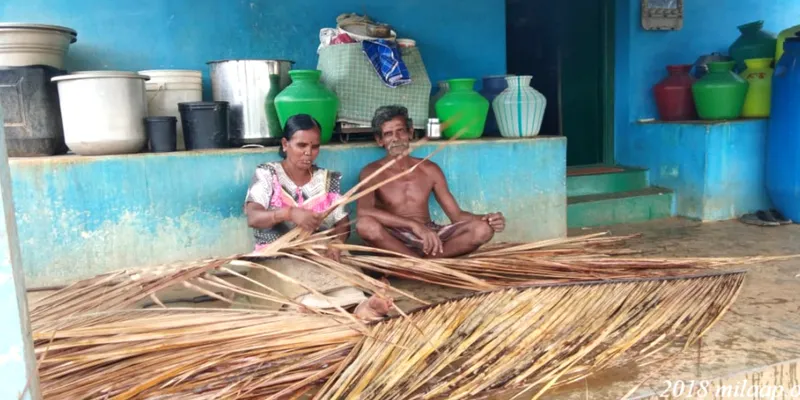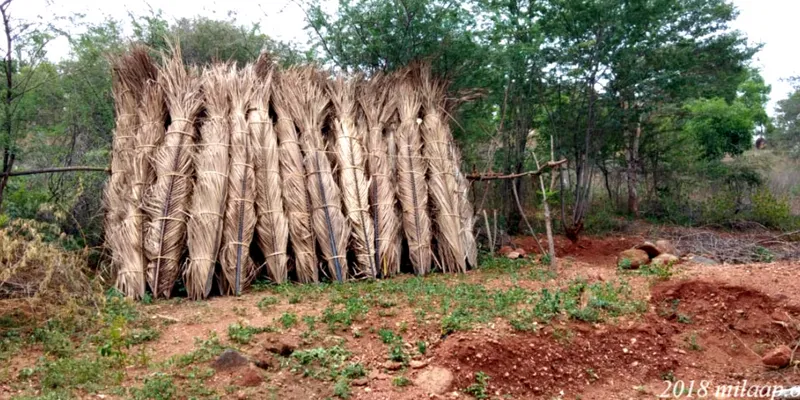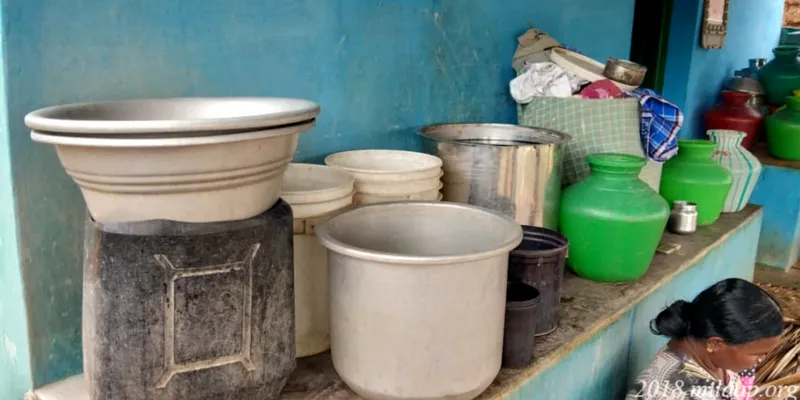How the age-old craft of weaving coconut palms in Tamil Nadu is slowly withering away
As development settles in and brings changes, many professions are fast disappearing. A small, tranquil village in Tamil Nadu is seeing one such generation-old craft dying a slow death.
With changing times, many old professions start losing their importance. During one of my visits to a small neighbourhood called Gandhinagar, placed in an unseen corner of the panchayat-run town - Thammampatti in Salem district, I came across a generation-old craft, and all I could think of was how I could let people know about it.

Rediscovering the age-old craft business
As I rode my scooter down the narrow lanes of this small town, we reached Gandhinagar. I saw rows of houses with thatched roofs as well as concrete houses standing on the top of a hill. The men and women were busy at work, the kids were at school, and the area was quiet and serene. We took the white-cemented roads to reach the top of the hill, the place where the Gandhinagar people lived and worked.
Nathiya, the first person I met there, was standing at the entrance of her house in a bright yellow saree, holding her three-year-old daughter in her arms. She welcomed me into her house, where a group of women were waiting. After a hearty conversation, they asked me if I wanted to see some of their work. I followed them through the narrow paths towards the back of the house.

The craft business called Thattai Pinnardu in Tamil - meaning braiding the coconut palm leaves, has been passed on through generations. People, especially women, weave fresh and dry coconut palm leaves, or ‘streaks’, to make roofs, sheds, gates etc. The dry leaves are put together and used as roofs and doors for thatched houses, and the fresh green leaves are used as festive decor.
“I used to see my grandmother weave and braid the leaves and, before I knew, I too started weaving with her,” says Chandra, a native of the village, reminiscing about her childhood days. She has been weaving coconut leaves for the past 40 years.

The people here purchase about 10 packs of leaves, each pack comprising around 50 leaves. They then soften them up by soaking the packs in water, which they never seem to have enough of. “Water is a major problem here. We need at least five to six buckets of water to soak the leaves, or they turn brittle and it becomes hard to weave them,” says Veeramutthu, Chandra’s husband.
Besides weaving the leaves, the people here also make ‘Koochi-vaaral’, a wooden broom from the leftover leaves. The dried leaves are also cut into thin slices using a small paper-cutter, and are arranged and tied up together to make roofs. Sometimes, for household purposes, they also make coconut oil from the dried nuts that are left behind on trees.
The water problem
Being situated on a hill, the area does not have ground water. Therefore, the residents end up buying water from local authorities. It gets delivered once every 25 days and they have to figure out various ways to store it till the next round of supply comes their way.
“We don’t have proper tanks to store water, and storing water in containers is an open invitation to mosquitoes and other vector-borne diseases,” says Nathiya. Her daughter fell sick and was diagnosed with dengue last year. Nathiya and other people living in the area are worried about their family’s health, and are slowly trying to quit this profession to lead a disease-free life.

“We don’t have many options here. We can either choose to continue this work of our ancestors and see the people get sick, or we find some other work that will pay us better and let us lead a healthy life,” says one of the women in the group.
The overall scenario
Sadly, this profession is seeing a slow death. The dry coconut-palm leaves are used only in villages and, today, people prefer plastic or asbestos sheets to be used as roofs and doors.
“Those are a little too costly, but the choices and priorities are changing,” says Chandra. Both her sons are now married and work in companies. Her disheartened husband explains how their way of life, which has revolved around working with these leaves, does not hold the younger generation’s interest. “The kids want something big. They don’t want to learn this work as it seems small to them,” he says.
It is sad to see a more-than-ten-generation-old profession disappear this way. Having no one to pass on the know-how of the craft to, the profession is on the brink of extinction.
“Of course it is sad, but what can you do?” says Veeramutthu. “I’ve made a living out of climbing these trees for over 30 years,” he says, holding a leaf in his hand. “But in a few years, people won’t even know that there was a profession like this. They wouldn’t know how difficult it is or how important it once was… for at least a few people like us,” his voice trails off.
Many parts of rural Tamil Nadu are seeing such professions lose their stability, as the young and educated move out of villages in search of more lucrative jobs. Those who do want to continue such professions have to deal with challenges such as water scarcity and lack of proper storage and drainage facilities.
It is sad that such beautiful craft professions are losing their importance, and with plastic flooding the markets, it is becoming even more difficult for them to sustain.
I want the readers to ponder if development means losing age-old traditional professions, or is there any way we can preserve them?
Disclaimer: This article was first published in Milaap. The views expressed by the author are his/her own and do not necessarily reflect that of YourStory.







